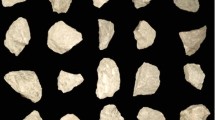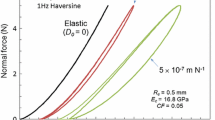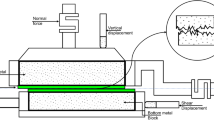Abstract
This paper gives the results of grain-to-grain sliding friction experiments on several naturally occurring geologic materials and two manufactured materials. The materials include quartz sands with mean grain size \(d_{ave}\) ranging from 0.14 to 3 mm, crushed and ball milled gneiss with \(d_{ave} = 14-20\) mm, magnesite (limestone) with \(d_{ave}=2\) mm, and Caicos ooids with \(d_{ave}=0.44\) mm. The reference materials include manufactured glass beads (\(d_{ave} = 0.30\) and 1.0 mm) and spheres of a synthetic material (Delrin, \(d_{ave} = 19.05\) and 5.08 mm). The experiments involved normal loads \(F_{N}\) that ranged from 0.46 to 20 N, depending on material, and the subsequent application of an increasing shear force at a loading rate of 1 \(\hbox {Ns}^{-1}\). This work contributes to the goal of providing high-fidelity contact models for use in discrete element simulations of naturally occurring granular materials. The results presented here provide a picture of shear force-displacement behavior up to and through the onset of macroscopic sliding. For natural materials with relatively rough surfaces, the coefficient of friction \(\mu \) ranged from 0.1 to 0.9 at normal force levels \(F_{N} < 10\) N, but tended to converge to a narrower range (0.24–0.62) at higher \(F_{N}\) levels. Grains with low surface roughness (glass beads, synthetic material and the 3-mm-diameter sand), on the other hand, exhibited a trend of decreasing \(\mu \) with increasing \(F_{N}\), with terminal values in the range of 0.1–0.2 for \(10 \le F_{N} \le 20\) N. This behavior is explained in terms of the relationship between the normal force and the true area of contact. Additionally, observations of free sliding observed under cyclic shear loading are reported.











Similar content being viewed by others
References
Pavelescu, D., Tudor, A.: The sliding friction coefficient—its evolution and usefulness. Wear 120, 321–336 (1987)
Bhushan, B.: Contact mechanics of rough surfaces in tribology—multiple asperity contact. Tribol. Lett. 4, 1–35 (1998)
Feeny, B., Guran, A., Hinrichs, N., Popp, K.: A historical review on dry friction and stick-slip phenomena. Appl. Mech. Rev. 51, 321–341 (1998)
Liu, G., Wang, Q., Lin, C.: A survey of current models for simulating the contact between rough surfaces. Tribol. Trans. 42, 581–591 (1999)
Barber, J.R., Ciavarella, M.: Contact mechanics. Int. J. Solids Struct. 37, 29–43 (2000)
Majumdar, A., Bhushan, B.: Fractal model of elastic-plastic contact between rough surfaces. J. Tribol. 113, 1–11 (1991)
Carpinteri, A., Paggi, M.: Size-scale effects on the friction coefficient. Int. J. Solids Struct. 42, 2901–2910 (2005)
Berman, A., Drummond, C., Israelachvili, J.: Amontons’ law at the molecular level. Tribol. Lett. 4, 95–101 (1998)
Bowden, F.P., Tabor, D.: The area of contact between stationary and between moving surfaces. Proc. R. Soc. A 169, 391–413 (1938)
Dieterich, J.H., Kilgore, B.D.: Direct Observation of frictional contacts: New insights for state-dependent properties. Pure Appl. Geophys. 143, 283–302 (1994)
Archard, J.F.: Elastic deformation and the laws of friction. Proc. R. Soc. A 243, 190–205 (1957)
Greenwood, J.A., Williamson, J.B.P.: Contact of nominally flat surfaces. Proc. R. Soc. A 295, 300–319 (1966)
Byerlee, J.: Friction of rocks. Pure Appl. Geophys. 116, 615–626 (1978)
Yoshioka, N., Scholz, C.H.: Elastic properties of contacting surfaces under normal and shear loads 2. Comparison of theory with experiment. J. Geophys. Res. 94, 17,691–17,700 (1989)
Biegel, R.L., Wang, W., Scholz, C.H., Boitnott, G.N.: Micromechanics of rock friction 1. Effects of surface roughness on initial friction and slip hardening in westerly granite. J. Geophys. Res. 97, 8951–8964 (1992)
Boitnott, G.N., Biegel, R.L., Scholz, C.H.: Micromechanics of rock friction 2: quantitative modeling of initial friction with contact theory. J. Geophys. Res. 97, 8965–8978 (1992)
Cavarretta, I., Rocchi, I., Coop, M.R.: A new interparticle friction apparatus for granular materials. Can. Geotech. J. 48, 1829–1840 (2011)
Cole, D.M., Uthus, L., Hopkins, M.A., Knapp, B.R.: Normal and sliding contact experiments on gneiss. Granul. Matter 12, 69–86 (2010). doi:10.1007/s10035-010-0165-z
Gefken, P.R., Florence A.L., Sanai, M.: Spherical Waves in Saturated Sand. Indian Head Division—Naval Surface Warfare Center Report IHCR 96-55 (1996)
Veyera, G.E.: Uniaxial Stress-Strain Behavior of Unsaturated Soils at High Strain Rates. Report WL-TR-93-3523, Wright Laboratory, Flight Dynamics Directorate, Tyndall AFB, FL (1994)
Cooper, W.F.: Shear stress measurements during high-speed impacts with sand and glass beads. In: Shock Compression of Condensed Matter—2011: Proceedings of the Conference of the American Physical Society Topical Group on Shock Compression of Condensed Matter, AIP Conf. Proc., vol. 1426, pp. 1455–1458. (2011). doi:10.1063/1.3686556
Uthus, L., Tutumluer, E., Horvli, I., Hoff, I.: Influence of grain shape and surface texture on the deformation properties of unbound aggregates in pavements. Int. J. Pavements Eng. 6, 75–87 (2007)
Uthus, L., Hopkins, M.A., Horvli, I.: Discrete element modelling of the resilient behaviour of unbound granular aggregates. Int. J. Pavement Eng. 9(6), 387–395 (2008)
Cole, D.M., Ringelberg, D., Reynolds, C.M.: Small-scale mechanical properties of biopolymers. J. Geotech. Geoenviron. Eng. (2011). doi:10.1061/(ASCE)GT.1943-5606.0000680
Andò, E., Hall, S.A., Viggiani, G., Desrues, J., Bésuelle, P.: Grain-scale experimental investigation of localised deformation in sand: a discrete particle tracking approach. Acta Geotech. 7, 1–13 (2012)
Knuth, M., Hopkins, M.A., Cole, D.M.: Discrete element modeling of Vicksburg sand and lunar simulant. Proc. ASCE Earth Space 2010, 42–48 (2010)
Cole, D.M., Peters, J.F.: Grain-scale mechanics of geologic materials and lunar simulants under normal loading. Granul. Matter 10, 171–185 (2008). doi:10.1007/s10035-007-0066-y
Peters, J.F., Berney, E.: Percolation threshold of sand-clay binary mixtures. J. Geotech. Geoenviron. Eng. 136, 310–318 (2010)
Ji, S., Hanes, D.M., Shen, H.H.: Comparisons of physical experiment and discrete element simulations of sheared granular materials in an annular shear cell. Mech. Mater. 41, 764–776 (2009)
Cole, D.M., Taylor, L.A., Liu, Y., Hopkins, M.A.: Grain-scale mechanical properties of lunar plagioclase and its simulant: initial experimental findings and modeling implications. In: Proceedings 12th Intl. Conf. on Engineering, Science, Construction, and Operations in Challenging Environments, pp. 74–83 (2010)
Cole, D.M., Hopkins, M.A.: Contact mechanics of naturally occurring grains: experiments and discrete element modeling. In: Powders and Grains 2009: Proceedings of the 6th Intl. Conf. on Micromechanics of Granular Media. AIP Conf. Proc., vol. 1145, pp. 351–354. (2009). doi:10.1063/1.3179931
Cole, D.M., Durell, G.D.: A dislocation-based analysis of strain history effects in ice. Philos. Mag. A 81, 1849–1872 (2001)
Johnson, K.L.: Contact Mechanics. Cambridge University Press, Cambridge (1985)
Acknowledgments
The author gratefully acknowledges the financial support of ERDC’s Military Engineering Basic Research Program. This work was made possible by the excellent technical support of Douglas Punt, William Burch and John Gagnon of ERDC-CRREL. Helpful comments on the manuscript from Dr. Mark Hopkins of ERDC-CRREL are gratefully acknowledged.
Conflict of interest
This work was solely supported by the US Army Corps of Engineers-Engineer Research and Development Center under the Military Engineering Basic Research Program. The data presented herein have not been previously published.
Author information
Authors and Affiliations
Corresponding author
Rights and permissions
About this article
Cite this article
Cole, D.M. Laboratory observations of frictional sliding of individual contacts in geologic materials. Granular Matter 17, 95–110 (2015). https://doi.org/10.1007/s10035-014-0526-0
Received:
Published:
Issue Date:
DOI: https://doi.org/10.1007/s10035-014-0526-0




